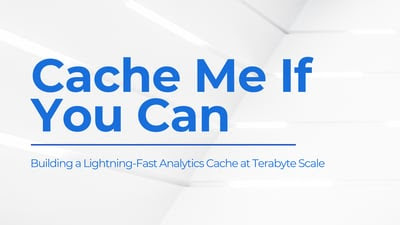Blog

Coupang, a Fortune 200 technology company, manages a multi-cluster GPU architecture for their AI/ML model training. This architecture introduced significant challenges, including:
- Time-consuming data preparation and data copy/movement
- Difficulty utilizing GPU resources efficiently
- High and growing storage costs
- Excessive operational overhead maintaining storage for localized data silos
To resolve these challenges, Coupang’s AI platform team implemented a distributed caching system that automatically retrieves training data from their central data lake, improves data loading performance, unifies access paths for model developers, automates data lifecycle management, and extends easily across Kubernetes environments. The new distributed caching architecture has improved model training speed, reduced storage costs, increased GPU utilization across clusters, lowered operational overhead, enabled training workload portability, and delivered 40% better I/O performance compared to parallel file systems.

Suresh Kumar Veerapathiran and Anudeep Kumar, engineering leaders at Uptycs, recently shared their experience of evolving their data platform and analytics architecture to power analytics through a generative AI interface. In their post on Medium titled Cache Me If You Can: Building a Lightning-Fast Analytics Cache at Terabyte Scale, Veerapathiran and Kumar provide detailed insights into the challenges they faced (and how they solved them) scaling their analytics solution that collects and reports on terabytes of telemetry data per day as part of Uptycs Cloud-Native Application Protection Platform (CNAPP) solutions.
.png)
.jpeg)
Notice anything new about our websites? That’s right - we are super excited to launch our new website - Alluxio.io! As we continue our focus on our open source community, one important item on our mind was to rebuild our website to provide better user experience for our community. To that end, you’ll see lots of changes in the Alluxio web experience.
.jpeg)
Alluxio is a proud sponsor and exhibitor of Spark+AI Summit in San Francisco. What’s Spark+AI Summit? It’s the world’s largest conference that is focused on Apache Spark - Alluxio’s older cousin open source project from the same lab (UC Berkeley’s AMPLab - now RISElab).
.jpeg)
Alluxio provides a distributed data access layer for applications like Spark or Presto to access different underlying file system (or UFS) through a single API in a unified file system namespace. If users only interact with the files in the UFS through Alluxio, since Alluxio has knowledge of any changes the client makes to the UFS, it will keep Alluxio namespace in sync with the UFS namespace.
.jpeg)
As part of the Alluxio 2.0 release, we have moved our RPC framework from Apache Thrift to gRPC. In this article, we will talk about the reasons behind this change as well as some lessons we learned along the way. In Alluxio 1.x, the RPC communication between clients and servers is built mostly on top of Apache Thrift. Thrift enabled us to define Alluxio service interface in simple IDL files and implement client binding using native Java interfaces generated by Thrift compiler. However, we faced several challenges as we continued developing new features and improvements for Alluxio.

China Unicom is one of the five largest telecom operators in the world. China Unicom’s booming business in 4G and 5G networks has to serve an exploding base of hundreds of millions of smartphone users. This unprecedented growth brought enormous challenges and new requirements to the data processing infrastructure. The previous generation of its data processing system was based on IBM midrange computers, Oracle databases, and EMC storage devices. This architecture could not scale to process the amounts of data generated by the rapidly expanding number of mobile users. Even after deploying Hadoop and Greenplum database, it was still difficult to cover critical business scenarios with their varying massive data processing requirements.
.jpeg)
In a recent blog, we discussed the ideation, design and new features in Alluxio 2.0 preview. Today we are thrilled to announce another new revolutionary project that the Alluxio engineering team has been hard at work on for the past year - the Alluxio Virtual Reality (VR) client.

Apache Spark has brought significant innovation to Big Data computing, but its results are even more extraordinary when paired with Alluxio. Alluxio, provides Spark with a reliable data sharing layer, enabling Spark to excel at performing application logic while Alluxio handles storage. Bazaarvoice uses the combination of Spark and Alluxio to provide a real time big data platform that has the ability to not only handle the intake of 1.5 billion page views during peak events like Black Friday, but also provide real time analytics against it (read more). At this scale, the gain in speed is an enabler for new workloads. We’ve established a clean and simple way to integrate Alluxio and Spark.
.jpeg)
Caching frequently used data in memory is not a new computing technique, however it is a concept that Alluxio has taken to the next level with the ability to aggregate data from multiple storage systems in a unified pool of memory.

We are thrilled and excited to announce the availability of Alluxio 2.0 Preview Release - the largest open source release with the most new features and improvements since the creation of the project. It is now available for download. While Alluxio already enabled data locality and data accessibility for many big data workloads in the cloud, there was still innovation needed in key areas.

.png)
.jpeg)